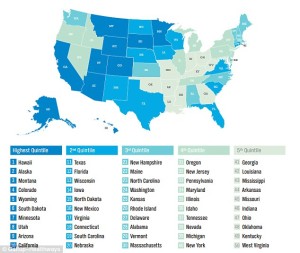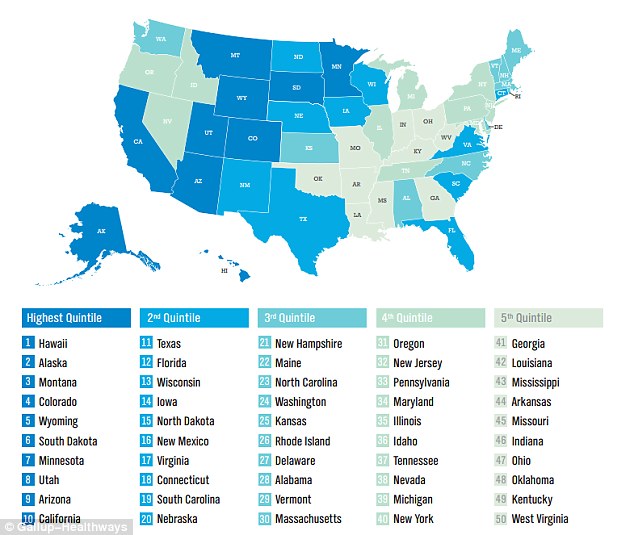 Where you live in the U.S. is a risk factor for your health. Hawaii, Alaska, Montana, Colorado and Wyoming rank highest on the State of American Well-Being 2015 State Well-Being Rankings, the Gallup-Healthways Well-Being Index.
Where you live in the U.S. is a risk factor for your health. Hawaii, Alaska, Montana, Colorado and Wyoming rank highest on the State of American Well-Being 2015 State Well-Being Rankings, the Gallup-Healthways Well-Being Index.
Well-Being is based on an index of five components that people self-assess: purpose, social, financial, community, and physical. See the map: the darker blue the state, the healthier the population perceives itself to be. Note more light blue to the northeast and south, and dark blue in the mountain states, Alaska and Hawaii.
Some states have stayed in the top-tier of wellness since 2012: Hawaii (#1 in 2015), Colorado, Montana, South Dakota, Minnesota, Utah, Nebraska, Iowa, Alaska, and Vermont. Except for Vermont, none of these states lie in the northeastern U.S., and none are situated in the south.
It is the south that tends to have people identifying with the lowest levels of well-being; the states that have tended to lie low in well-being for several years include West Virginia, Kentucky, and Mississippi In 2015, three Midwestern states joined southern states in poorest well-being: Indiana, Missouri and Ohio.
The Well-Being Index found last year that where you live is also associated with your likelihood of faring well after a heart attack. It turns out the states where people have lower BMI are also those with better cardiovascular outcomes.
Health Populi’s Hot Points: Your zip code is more important than your genetic code, as the Robert Wood Johnson Foundation has asserted. So, then, does it follow that geography is destiny when it comes to our health status?
The answer lies in the social determinants of health, the aspects of daily living which bolster or diminish human health outside of the healthcare system. These include financial wellness, food, safe streets and living environments, education — in my economics education, all considered inputs into human capital. Improve access to and quality of early childhood education, young peoples’ nutrition, and a safe community, and you’ve got the groundwork for better health outcomes and economic development. My economist gurus Gary Becker and Jeffrey Sachs have often written about this, among many other scholars making the case.
Some examples of health care dealing head-on with #SDOH are…
- When Kaiser’s health plan works with farmers’ markets in communities that lack fresh produce
- The University of Kansas creating and promoting the Community Toolbox
- Purple Binder working with health system partners to link patients to needed social services like heat and utilities, education and jobs.
And increasingly, health insurance plan sponsors — especially employers — are focusing on well-being’s role in worker productivity and workplace engagement.
For more real-time learnings about the social determinants of health, follow the #SDOH hasthtag on Twitter.





 I love sharing perspectives on what's shaping the future of health care, and appreciate the opportunity to be collaborating once again with Duke Corporate Education and a global client on 6th May. We'll be addressing some key pillars to consider in scenario planning such as growing consumerism in health care, technology (from AI to telehealth), climate change, and trust -- the key enabler for health engagement or dis-engagement and mis-information. I'm grateful to be affiliated with the corporate education provider
I love sharing perspectives on what's shaping the future of health care, and appreciate the opportunity to be collaborating once again with Duke Corporate Education and a global client on 6th May. We'll be addressing some key pillars to consider in scenario planning such as growing consumerism in health care, technology (from AI to telehealth), climate change, and trust -- the key enabler for health engagement or dis-engagement and mis-information. I'm grateful to be affiliated with the corporate education provider  Thank you FeedSpot for
Thank you FeedSpot for